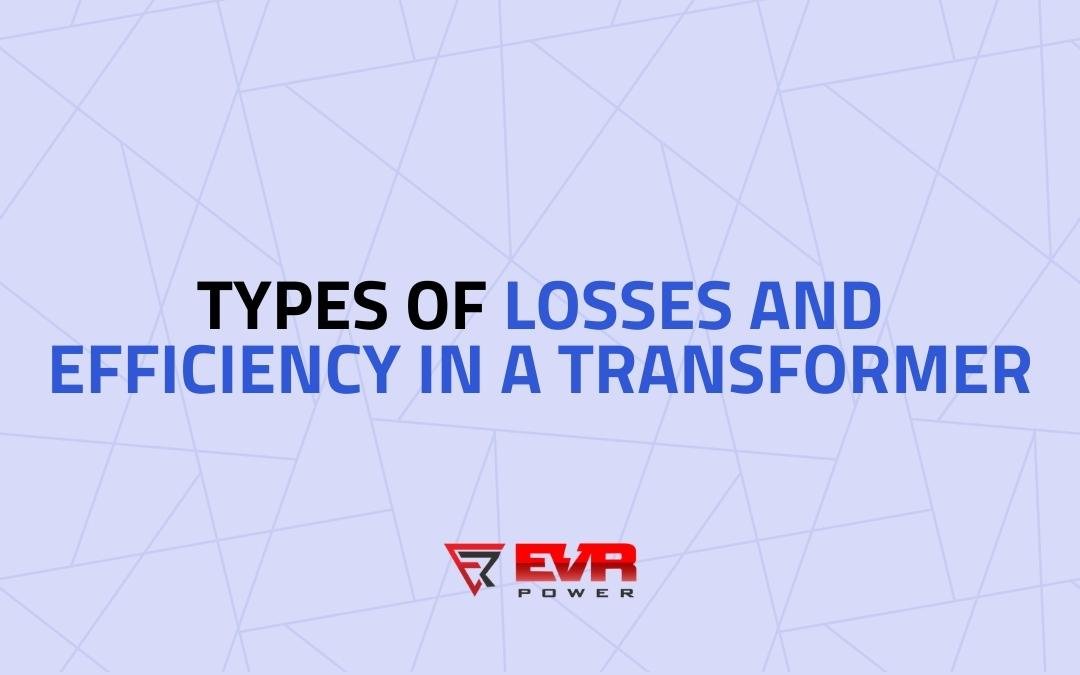Almost every electrical and electronic appliance requires a transformer to bring in a safe amount of power for effective and safe performance. A device with such enormous importance has to be efficient in its function to perform seamlessly. The efficiency of a transformer is a measure of the reliability and operational performance of the product. Efficiency in a transformer is computed as the ratio of output power to input power and is represented in percentage. In most cases, the output power of a transformer is always slightly less than the input power of the transformer.
An ideal transformer is one with NO energy loss. But in practical, Transformers do undergo power losses due to various reasons. The reason we are talking about losses here is that there is a strong correlation between the losses and Efficiency in a transformer. More on that later, let us first understand the various losses in transformer the ways to minimize them.
Losses in Transformer:
There are different types of losses and it is important that you know the cause and effect it has on the input power of the transformer. This will help you choose a better and more sustainable product in the market. EVR Power, one of the top transformer manufacturers in India has brought you this article to make it easier for you.

So here’s all you need to know about losses in transformers, There are four main types of losses in transformers,
- Resistive / Copper loss
- Iron or Core loss – Eddy current loss & Hysteresis loss
- Stray loss
- Dielectric loss
1. Resistive Loss
Resistive loss is the power loss in a transformer caused due to the ohmic resistance of the copper wire used to make the windings. The power is dissipated in the form of heat due to the electric currents in the conductors of transformer primary and secondary windings. These losses are also called copper losses or ohmic losses. The resistive loss is directly proportional to the square of the current flowing through it. The current flowing through the windings is dependent on the load connected to it. Since these losses are variable with load, they are also termed variable losses.
2. Iron or Core losses
The core of the transformer is the one that links both the primary and secondary windings by magnetic induction. The losses that occur in the magnetic core are called iron or core losses in the transformer. There are two main types of iron or core losses – Eddy Current loss and Hysteresis loss. These losses are independent and irrespective of the load connected to the transformer as the iron core remains static and practically constant in all load conditions.
1. Eddy Current Loss
Eddy’s current loss is due to the magnetic effects in the transformer. Eddy currents are currents circulating the magnetic core of the transformer. As we know, the iron core is the main part of the transformer that channels the power from primary to secondary windings. When an electrical conductor like iron is placed in an alternating magnetic field, an Electro-magnetic force or emf is generated inside the iron and creates circulating currents in the solid iron core. These Eddy currents take up energy and produce heat in the system. In any electrical circuit, whenever there is heat produced there will be some loss. This loss reduces the efficiency of the transformer and is called Eddy Current Loss.
Eddy Current losses can be minimized by using a thicker iron core made up of a galvanized and a laminated thin layer of iron sheets insulated with paint or varnishes. As the cross-section area of each lamination is now much smaller, Eddy currents are much reduced and thereby less eddy current losses and greater efficiency.
2. Hysteresis Loss
Hysteresis is a phenomenon that occurs in the core of the electrical device due to magnetization and demagnetization of the material. Due to the alternative current on the input terminal, the iron core gets magnetized and demagnetized in each cycle and some energy is lost in the process.
The hysteresis losses of the transformer cannot be eliminated but can be minimized by choosing low hysteresis coefficient material. The energy loss associated with hysteresis is directly proportional to the area of the hysteresis loop. That means if you use a material whose area of the hysteresis loop is smaller, the hysteresis losses will be remarkably lesser. So a high-grade core material like CRGO – Cold rolled grain oriented Silicon Steel can lower the hysteresis losses to a greater extent.
3. Stray loss
We all know that a transformer works on a principle of mutual induction wherein the alternating current in the primary winding produces magnetic flux lines by which emf is induced in the secondary winding. But in real-time, all the flux produced by the primary side does not link with the secondary side completely. This is called a flux leakage and will cause some losses in the transformer reducing the output power. This type of loss is known as Flux loss or Stray loss.
The primary and secondary windings of the transformer must be wound in such a manner that flux coupling among the coils is maximum. In this way, we can ensure utmost power transfer from primary to secondary during flux linkages thereby decreasing flux losses.
4. Dielectric loss
Dielectric loss occurs in the insulating medium of the transformer. In general, Oil is used as a dielectric medium. Due to the continuous operation of the transformer, the strength of the dielectric is reduced. When the quality of the oil deteriorates, it causes some losses known as Dielectric losses which decrease the overall efficiency of the transformer.
Frequent checks on the quality and condition of the dielectric medium can help avoid such losses.
The efficiency of a transformer
Transformer efficiency is the ratio of real output power to real input power and is denoted in percentage. If the losses are very minimal, this ratio will be close to 1. On the other hand, if 25% of the input power is lost due to the above-mentioned losses, then the efficiency comes around 75%.
Efficiency = {Output power ⁄ Input Power} * 100
= {Output power ⁄ (Output power + Iron losses + Copper losses + Stray losses + Dielectric losses )} * 100
The percentage of Stray and dielectric loss compared to Iron and Copper losses are very less and hence negligible.
= {Output power ⁄ (Output power + Iron losses + Copper losses)} * 100
If Output power equals input power in a transformer, then the efficiency is 100%. While it is difficult to achieve 100% efficiency during practical operations, it is possible to have maximum efficiency in a transformer when appropriate design and construction are undertaken.
A Transformer with maximum efficiency is advantageous in many ways as it
- Leads to significant energy savings
- Lower electricity bills
- Economical as it benefits over the lifetime of the equipment
- Increased reliability
Conclusion
Now you know for yourself the types of losses in transformer and their impact on efficiency. So next time you buy a transformer, ask your manufacturer if necessary steps are taken care to enhance transformer efficiency.
EVR Power is one of the established manufacturers in the transformer industry. It engages in many technical solutions for improving Transformer energy efficiency such as better core construction techniques, winding designs, better interconnections, etc. These techniques have a considerable impact in minimizing the load losses and thereby maximizing efficiency. If you would like to consider our transformers for your business or if you need any service/repairs, please do contact us. We would be happy to help you.
If you have any queries about this topic, please do let us know in the comments.


0 Comments
Trackbacks/Pingbacks